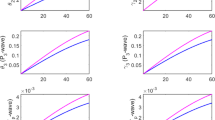Abstract—In the scope of Frenkel’s equation, an analytical solution is obtained for pore pressure and electrokinetically induced electric field caused by the Rayleigh surface wave propagation in a poroelastic fluid-saturated medium. The problem is solved in the frequency domain with the allowance for the boundary condition on the Earth’s surface. It is shown that the solution can be represented in the form of a sum of two waves, the first prevailing in the near-surface layer and rapidly decaying with depth, and the second covering a much greater depth interval and associated with longitudinal component of the Rayleigh wave. The rate of exponential decay of the first wave with depth is determined by the skin depth which, in turn, depends on the permeability coefficient of a poroelastic medium and on a number of other parameters. As a result, vertical component of the electric field associated with the first wave is highly sensitive to the change in the permeability of the surface layer, which opens the possibility of its determination from the observed seismoelectric signal. The first wave creates the dominant part of the electrokinetic effect on the surface. In accordance with the Helmholtz-Smoluchowski equation, we derived the expressions for the vertical and horizontal components of the electric field strength. Based on the estimated parameters of the Rayleigh wave recorded in the region of Mt. Wrangell, Alaska after the M = 9.0 Sumatran 2004 earthquake, the expected amplitudes of the vertical component of the coseismic electric field are found to range between dozens of µV/m and tenths to units of V/m. It is shown that the amplitudes and the skin depth for this component substantially depend on the permeability coefficient of the medium.



Similar content being viewed by others
REFERENCES
Alekseev, D.A. and Gokhberg, M.B., On the possibility of estimation of the Earth crust’s properties from the observations of electric field of electrokinetic origin, generated by tidal deformation within the fault zone, Izv., Phys. Solid Earth, 2018, vol. 54, no. 3, pp. 487–503.
Alekseev, D.A. and Gokhberg, M.B., Tidal generated electric field in the multi-layer structure and the possibilities of its employment for deriving the elastic properties and permeability of the subsurface formations, Izv., Phys. Solid Earth, 2019, vol. 55, no. 2, pp. 337–347.
Biot, M., General solutions of the equations of elasticity and consolidation for a porous material, J. Appl. Mech., Trans. Am. Soc. Mech. Eng., 1956, vol. 78, pp. 91–96.
Fizicheskie velichiny. Spravochnik (Physical Quantities: A Reference), Grigor’ev, I.S. and Meilikhov, E.Z., Eds., Moscow: Energoatomizdat. 1991. Frenkel’, Ya.I., On the theory of seismic and seismoelectric phenomena in wet soil, Izv. Akad. Nauk SSSR, Ser. Geogr. Geofiz., 1944, vol. 8, no. 4, pp. 134–149.
Garagash, I.A., Gokhberg, M.B., and Kolosnitsyn, N.I., Monitoring deformation processes based on observations of vertical component of the electric field, in Ocherki geofizicheskikh issledovanii (Essays on Geophysical Research), Moscow: OIFZ RAN, 2003, pp. 250–256.
Garagash, I.A., Gokhberg, M.B., and Kolosnitsyn, N.I., Monitoring of deformation process by means of electric field observation, in Mud Volcanoes, Geodynamics and Seismicity, Martinelli, G. and Panahi, B., Eds., Dordrecht: Springer, 2005, pp. 171–179.
Gershenson, N. and Bambakidis, G., Modeling of seismo-electromagnetic phenomena, Russ. J. Earth Sci., 2001, vol. 3, no. 4, pp. 247–275.
Gokhberg, M.B., Kolosnitsyn, N.I., and Nikolaev, A.I., Tidal deformations and the electrokinetic effect in a two-layer fluid-saturated porous medium, Izv., Phys. Solid Earth, 2007, vol. 43, no. 8, pp. 702–706.
Gokhberg, M.B., Kolosnitsyn, N.I., and Lapshin, V.M., Electrokinetic effect in the near-surface layers of the Earth, Izv., Phys. Solid Earth, 2009, vol. 45, no. 8, pp. 633–639.
Ivanov, A., Effect of electrization of Earth layers by elastic waves passing through them, Dokl. Akad. Nauk SSSR, 1939, no. 24, pp. 42–45.
Ivanov, A.G., Seismoelectric effect of the second kind, Izv. Akad. Nauk SSSR, Ser. Geogr. Geofiz. 1940, no. 5, pp. 600–727.
Jouniaux, L. and Zyserman, F., A review on electrokinetically induced seismo-electrics, electro-seismics, and seismo-magnetics for Earth sciences, Solid Earth, 2016, vol. 7, pp. 249–284.
Landau, L.D. and Lifshits, E.M., Teoriya uprugosti, tom 7, Teoreticheskaya fizika v 10-ti tomakh (Theory of Elasticity, vol. 7 of Theoretical Physics in 10 vols.), 3rd ed., Moscow: Nauka, 1965.
Leibenzon, L.S., Kurs teorii uprugosti (Elasticity Theory Course), Moscow–Leningrad: Gostekhizdat, 1947.
Naumovich, A., Efficient numerical methods for the Biot poroelasticity system in multilayered domains, Ph. D. Thesis, Kaiserslautern: Technische Universität Kaiserslautern, 2007.
Physical Properties of Rocks. A Workbook, vol. 8, Schön, J.H., Ed., Kidlington: Elsevier, 2011.
Potapov, O.A., Lizun, S.A., Kondrat, V.F., et al., Osnovy seismoelektrorazvedki (Basics of Seismoelectric Prospecting), Moscow: Nedra, 1995.
Pride, S.R., Governing equations for the coupled electromagnetics and acoustics of porous media, Phys. Rev., 1994, vol. B50, pp. 15678–15696.
Revil, A. and Jardani, A., Seismoelectric response of heavy oil reservoirs: theory and numerical modelling, Geophys. J. Int., 2010, vol. 180, pp. 781–797.
Revil, A., Jardani, A., Sava, P., and Haas, A., The Seismoelectric Method: Theory and Applications, Chichester: Wiley, 2015.
Surkov, V.V., Elektromagnitnye effekty pri zemletryaseniyakh i vzryvakh (Electromagnetic Effects from Earthquakes and Explosions), Moscow: MIFI, 2000.
Svetov, B.S., Osnovy geoelektriki (Basics of Geoelectrics), Moscow: LKI, 2008.
Svetov, B.S., Self-consistent problems of geoelectrics, in Electomagnetic Sounding of the Earth’s Iinterior: Theory, Modeling, Practice, 2nd ed., Spichak, V.V., Ed., Amsterdam: Elsevier, 2015, pp. 79–106.
Thompson, R.R., The seismic-electric effect, Geophysics, 1936, vol. 1, no. 3, pp. 48–51.
West, M., Sanchez, J.J., and McNutt, S.R., Periodically triggered seismicity at Mount Wrangell, Alaska, after the Sumatra earthquake, Science, 2005, vol. 308, pp. 1144–1146.
Funding
The work was supported by the Russian Foundation for Basic Research under project no. 20-05-00691.
Author information
Authors and Affiliations
Corresponding author
Ethics declarations
The authors declare that they have no conflicts of interest.
Additional information
Translated by M. Nazarenko
Rights and permissions
About this article
Cite this article
Gokhberg, M.B., Kolosnitsyn, N.I., Pliss, A.O. et al. Seismoelectric Effect Associated with Rayleigh Wave Propagation. Izv., Phys. Solid Earth 58, 267–273 (2022). https://doi.org/10.1134/S1069351322020033
Received:
Revised:
Accepted:
Published:
Issue Date:
DOI: https://doi.org/10.1134/S1069351322020033




